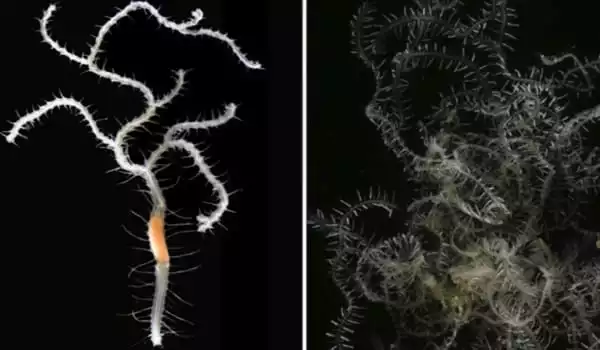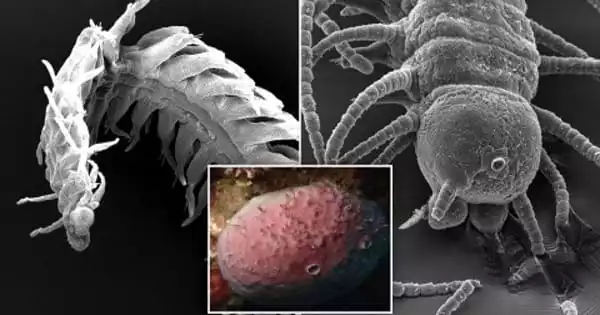Branching marine worms are strange creatures with a single head but a body that branches repeatedly into multiple posterior ends. Until now, only two species of these strange beasts, thought to be extremely rare, had been identified. An international research team led by the University of Göttingen, however, discovered and described a third species. The worm, named Ramisyllis kingghidorahi after Godzilla’s monster foe King Ghidorah, was discovered in Japan. The research was published in the journal Organisms Diversity & Evolution.
During reproduction, a newly discovered species of branched sea worm has dozens of regenerative rear ends that detach and swim away. The beastie’s strange superpower prompted its discoverers to name it after Godzilla’s monstrous multiheaded nemesis, King Ghidorah.
In total, 25 of the new worms, dubbed Ramisyllis kingghidorahi after the villainous kaiju, were discovered in Japan in October 2019. Unlike their namesake, which has three heads and two tails, R. kingghidorahi has only one head but multiple posterior branches that grow to fill out narrow tubes inside their host sponges that are 2 to 4 inches (5 to 10 centimeters) long.
King Ghidorah is a fictitious branching animal that can regenerate its lost ends, so we thought this was an appropriate name for the new species of branching worm. We were astounded to discover another of these strange creatures with only one head and a body made up of multiple branching. The first worm was thought to be unique, but this discovery reveals a greater diversity of these tree-like animals than anyone expected.
Professor M. Teresa Aguado
The branching worm was discovered by Japanese researchers, who sent images to Professor M. Teresa Aguado of the University of Göttingen. Aguado recognized the significance of the discovery right away and organized a field trip to Japan’s Sado Island. The new species is named after King Ghidorah, Godzilla’s three-headed, two-tailed, and monstrous arch-enemy from Japanese mythology and folklore. “King Ghidorah is a fictitious branching animal that can regenerate its lost ends, so we thought this was an appropriate name for the new species of branching worm,” Aguado says.
When the worms reproduce, the tip of each branch, known as a stolon, detaches and swims to the surface, releasing eggs or sperm that are then mixed in the water column, where fertilization occurs. The stolons die, but the worms remain safe inside their spongy hosts, regenerating the lost sections of each branch for the next reproductive cycle.

These branching worms live inside the internal canals of sea sponges. There are now three known species: Syllis ramosa McIntosh, discovered in 1879 in the Philippines, which lives in deep-sea glass sponges; Ramisyllis multicaudata, discovered in 2012 north of Australia; and the new Ramisyllis kingghidorahi, discovered in Japan. The two most recently discovered worms live in different types of stony sponges found in shallow water. “We were astounded to discover another of these strange creatures with only one head and a body made up of multiple branching. “The first worm was thought to be unique,” Aguado says, “but this discovery reveals a greater diversity of these tree-like animals than anyone expected.”
This new species was described by a multidisciplinary team of scientists from Germany, Spain, Australia, and Japan who combined their expertise in morphology, internal anatomy, ecology, phylogeny, genetic divergence, and mitochondrial genomics. The evolutionary relationships uncovered by molecular analyses show that the two most recently discovered branching worms, from northern Australia and Japan, share a common ancestor.
They do, however, exhibit high genetic divergence, as well as ecological and morphological differences, most notably in the shape of certain body segments. The asymmetrical branching body may have been passed down from their last common ancestor, who had most likely already adapted to living inside a sponge canal system. The ability of many worms to produce new posterior segments throughout their lives, combined with their regenerative capacities and the ability of the worms to produce several simultaneously newly formed segments during reproduction, may be the basis of the evolution of a branching body.
Despite the fact that these worms have been around for over a century, many mysteries remain. Aguado elaborates: “Scientists do not yet understand the nature of the branching worm’s relationship with its host sponge: is it a symbiotic relationship in which both creatures benefit? And how do the worms feed to keep their massive bodies going with only one tiny mouth in their single head?”





